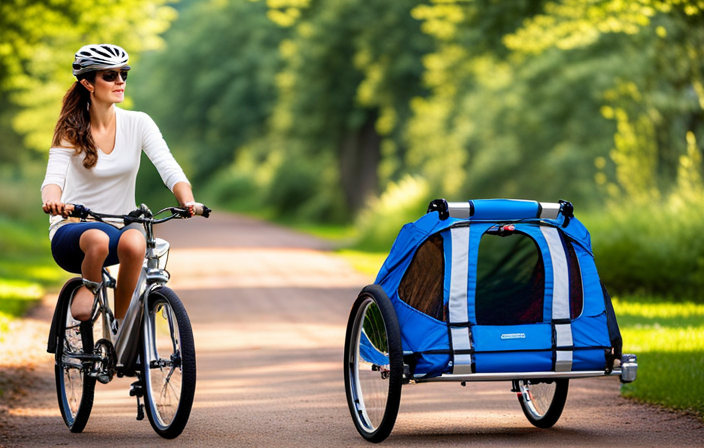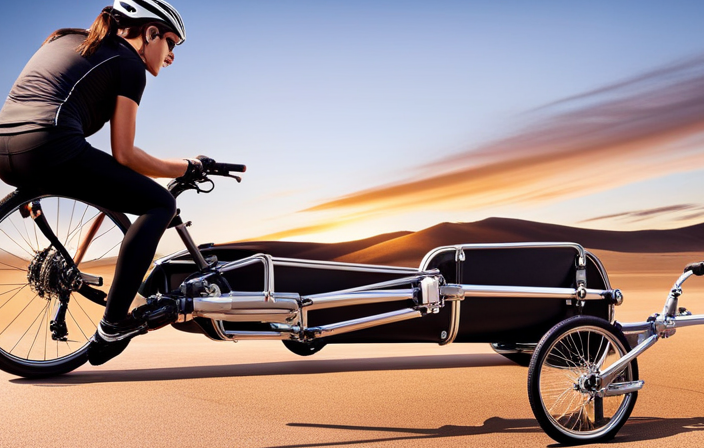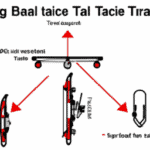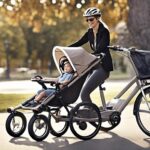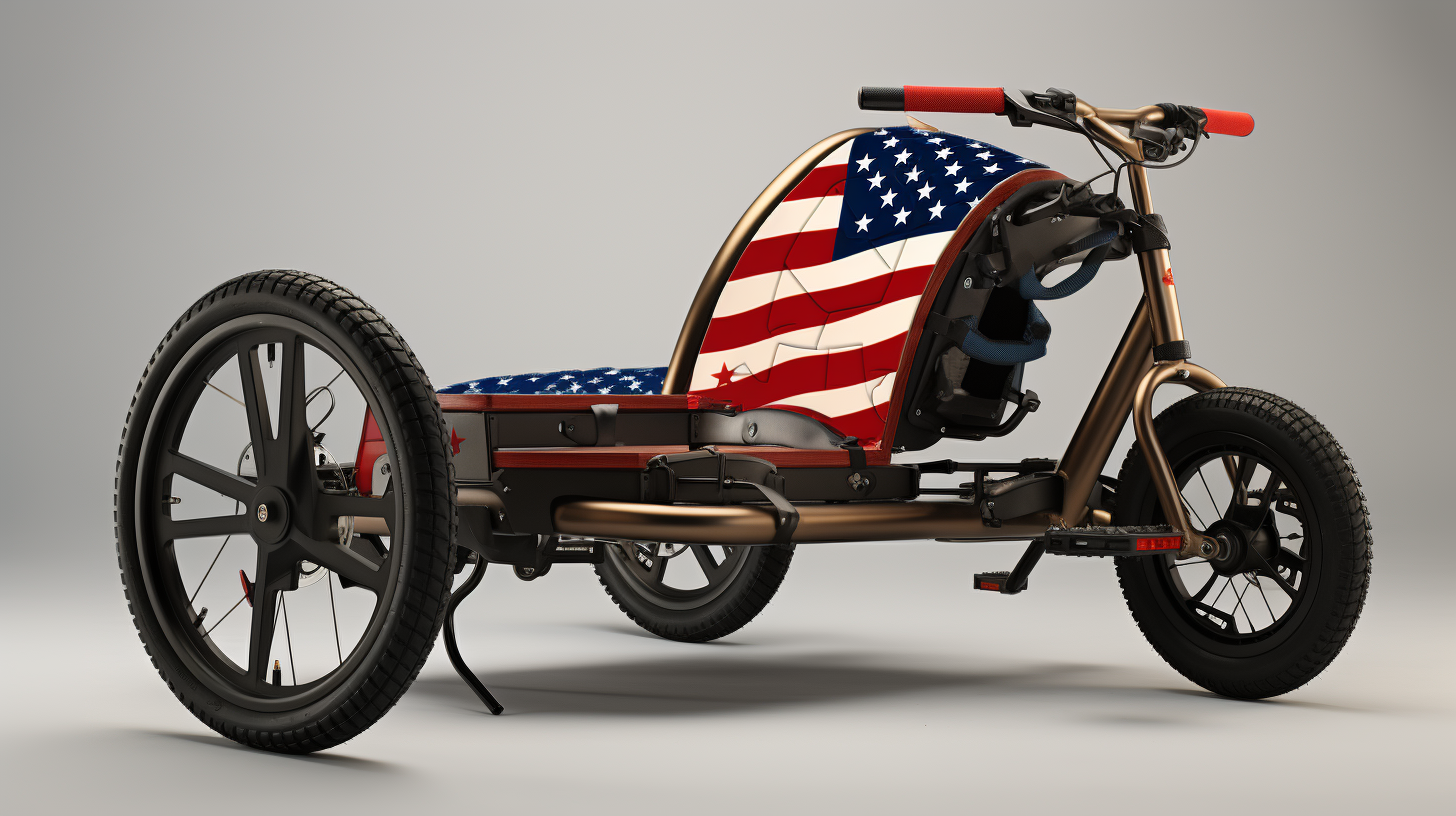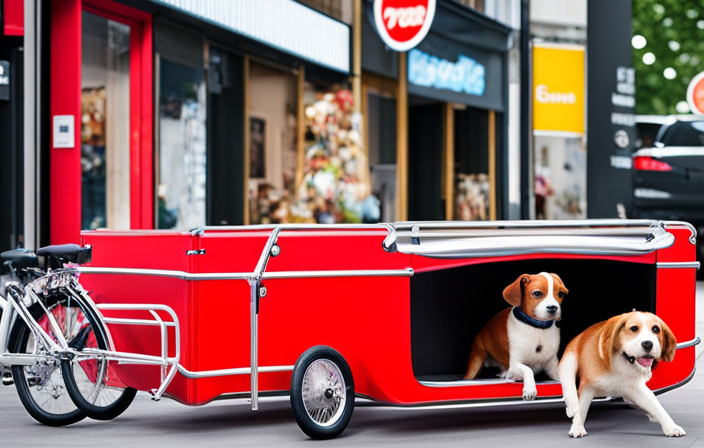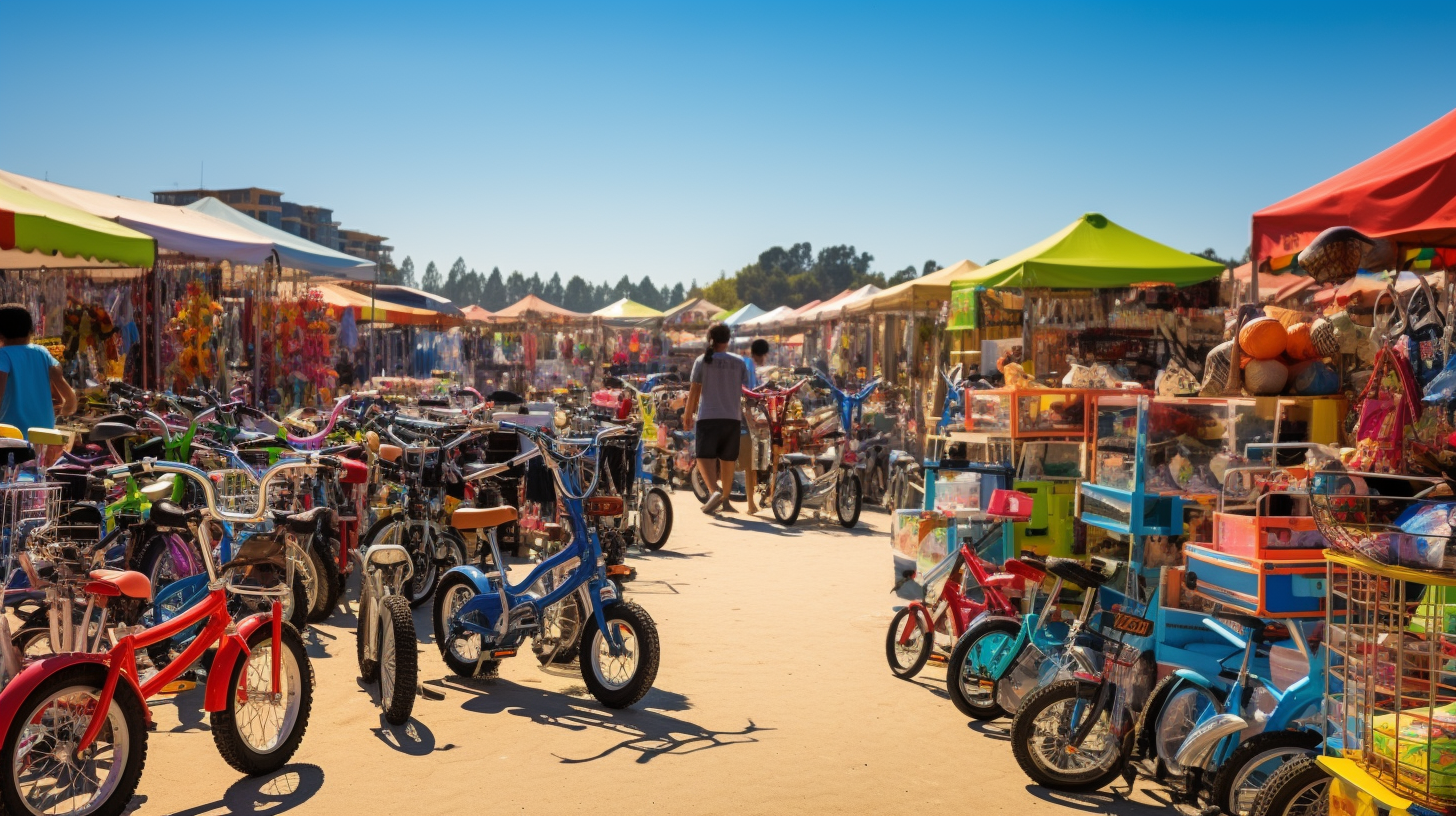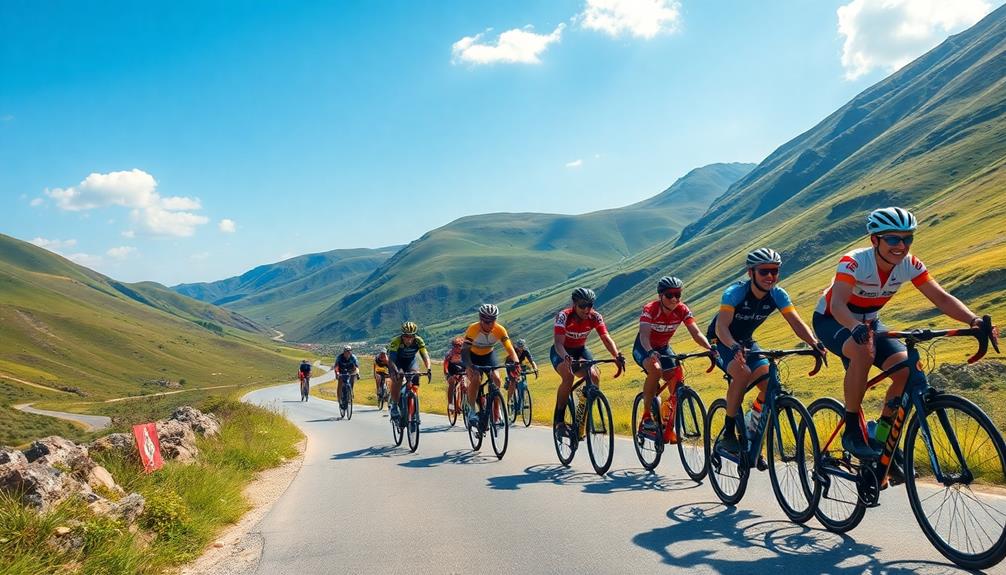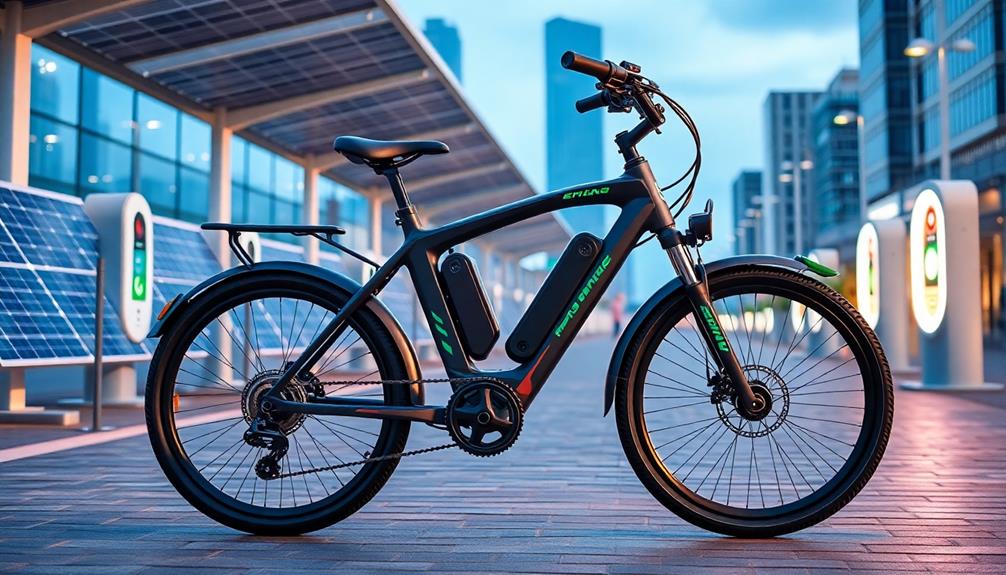As a parent who loves cycling, I have always been worried about the safety of bike trailers. Did you realize that recent research shows a rise in bike trailer accidents? This is why it is important to fully grasp the safety regulations, select a top-notch trailer, and correctly attach and care for it.
In this article, we’ll explore the precautions and guidelines to ensure your child’s well-being and address the risks associated with bike trailer use. So let’s dive in and make informed decisions for a safer biking experience with our little ones.
Key Takeaways
- Regularly check and secure the hitch to prevent detachment
- Choose a bike trailer with a sturdy frame, reliable brakes, and reflective materials
- Follow the manufacturer’s instructions for weight capacity and age restrictions
- Always wear helmets and follow safety guidelines, such as using additional safety accessories and sticking to designated bike paths
Understanding Bike Trailer Safety Standards
You should ensure that your bike trailer meets all the necessary safety standards. Bike trailer safety regulations are in place to protect both the rider and the passenger. It is crucial to understand and adhere to these regulations to prevent accidents and ensure a safe riding experience.
One common bike trailer accident is tipping over. This can happen if the trailer is not properly balanced or if too much weight is placed on one side. To avoid this, always distribute the weight evenly and secure the load properly.
Another common accident is the trailer detaching from the bike. This can occur if the hitch is not properly installed or if it becomes loose during the ride. To prevent this, regularly check the hitch and ensure it is securely attached to your bike.
Additionally, make sure your bike trailer has proper safety features such as a sturdy frame, reliable brakes, and reflective materials for visibility. Check for any sharp edges or loose parts that could pose a risk of injury. It is also important to follow the manufacturer’s instructions for maximum weight capacity and age restrictions.
By understanding and following bike trailer safety regulations, you can greatly reduce the risk of accidents and ensure a safe ride for you and your passenger.
Now let’s move on to the next section, where we will discuss how to choose a high-quality bike trailer.
Choosing a High-Quality Bike Trailer
When looking for a top-notch option, it’s important to consider factors like durability, weight capacity, and ease of attachment. To ensure you choose a high-quality bike trailer, here are some key features to look for:
- Sturdy frame: Opt for a trailer with a strong and durable frame that can withstand the rigors of the road.
- Suspension system: A good suspension system helps absorb shocks and provides a smoother ride for your child.
- Safety harness: Look for a trailer that has a secure and adjustable safety harness to keep your child safe and secure.
- Weather protection: Make sure the trailer has a weather-resistant cover to shield your child from rain, wind, and sun.
- Reflective elements: Look for trailers with reflective strips or panels to enhance visibility, especially during low-light conditions.
When it comes to bike trailer safety tips, here are a few things to keep in mind:
- Always wear a helmet: Both you and your child should wear helmets while riding in a bike trailer.
- Stick to designated bike paths: Avoid busy roads and opt for bike paths or trails that are safer for you and your child.
- Follow weight capacity guidelines: Don’t exceed the recommended weight limit of the trailer to ensure its stability and safety.
By considering these bike trailer features and following safety tips, you can ensure a safe and enjoyable ride for you and your child.
Now, let’s discuss how to ensure proper bike trailer attachment.
Ensuring Proper Bike Trailer Attachment
To properly attach a bike trailer, it’s essential to follow the manufacturer’s instructions and ensure a secure connection. Proper bike trailer installation is crucial for a safe and enjoyable ride. Before starting, I carefully read the instructions provided by the manufacturer. I make sure I understand the process thoroughly before proceeding. Once I have familiarized myself with the instructions, I begin by attaching the trailer’s hitch to the rear axle of my bike. I ensure that the connection is secure and that there is no wobbling or movement.
Next, I fasten any additional straps or safety features according to the manufacturer’s guidelines. Securing cargo in bike trailers is equally important. I distribute the weight evenly, placing heavier items closer to the bike’s center of gravity. I check that all cargo is securely strapped down, reducing the risk of it shifting during the ride.
By following these steps, I can be confident in the proper attachment of my bike trailer and the safe transportation of my cargo.
When it comes to bike trailers, checking for sturdy construction and durability is another vital aspect.
Checking for Sturdy Construction and Durability
Checking for sturdy construction and durability is essential when selecting a bike trailer. As a cautious and analytical buyer, I understand the importance of these qualities in ensuring the safety of my child or cargo during rides.
Sturdy construction refers to the overall build quality of the trailer, including the frame, hitch, and wheels. It is crucial to examine the materials used and the design to ensure they can withstand the rigors of the road.
Durability, on the other hand, refers to the trailer’s ability to withstand wear and tear over time. This includes factors such as weather resistance, quality of the fabric, and the overall craftsmanship.
By carefully assessing the sturdy construction and durability of a bike trailer, I can be confident in its ability to provide a safe and reliable mode of transportation for my loved ones.
Now, let’s move on to assessing the trailer’s weight limit, another important aspect to consider when choosing a bike trailer.
Assessing the Trailer’s Weight Limit
As a cautious buyer, it’s important to consider the weight limit of the trailer. This will ensure that it can safely accommodate your cargo or child during rides. Evaluating safety features and determining the appropriate age range are crucial aspects of assessing the trailer’s weight limit. Here are three key factors to consider when evaluating the weight limit:
-
Cargo or Child Weight: Start by determining the weight of your cargo or child. It’s essential to choose a trailer that can comfortably handle their weight. Overloading the trailer can compromise its stability and put your cargo or child at risk.
-
Trailer Design and Construction: Look for trailers that are built with durable materials and sturdy construction. A well-designed trailer will have a higher weight limit and offer better stability during rides. Pay attention to the trailer’s frame, wheels, and suspension system.
-
Safety Features: Besides the weight limit, it’s important to evaluate the safety features of the trailer. Look for trailers with secure harness systems, reliable brakes, and reflective elements for visibility. These features will enhance the safety of your cargo or child during rides.
Considering the weight limit of the trailer is just the first step in ensuring a safe ride. Once you’ve determined an appropriate weight limit, you need to focus on securing your child with proper harnesses and other safety features.
Securing Your Child with Proper Harnesses and Safety Features
Ensure your child is securely fastened with proper harnesses and safety features. When it comes to bike trailers, the safety of your child should be your utmost priority. Proper seat positioning is crucial to ensure your child’s comfort and safety during the ride. Make sure that the seat is adjusted according to your child’s height and weight, providing adequate support and preventing any unnecessary movements. Additionally, always double-check the harnesses to make sure they are properly secured and snugly fitting. This will prevent your child from slipping or getting injured in case of sudden movements or emergency braking techniques.
Proper seat positioning and securely fastened harnesses are essential for the overall safety of your child while using a bike trailer. It is crucial to follow these precautions to minimize any potential risks or accidents.
Moving forward, it is equally important to regularly check for proper ventilation and sun protection in the bike trailer. Ensuring that your child is comfortable and protected from extreme weather conditions will further enhance their safety and enjoyment during the ride.
Checking for Proper Ventilation and Sun Protection
Proper ventilation and sun protection are crucial for keeping your child comfortable and protected while using a bike trailer. As a parent, I understand the importance of ensuring my child’s safety and well-being during our bike rides. Here are some key points to consider regarding ventilation and sun protection:
-
Mesh windows: Look for bike trailers that have mesh windows on the sides and back. These windows allow for proper airflow, keeping your child cool and preventing any stuffiness inside the trailer.
-
Sunshade: A sunshade is essential to protect your child from harmful UV rays. Make sure the trailer you choose has a large, adjustable sunshade that provides ample coverage.
-
Ventilation flaps: Some trailers come with additional ventilation flaps that can be opened or closed depending on the weather. These flaps allow for better airflow and can be particularly useful during hot summer days.
-
UPF-rated fabric: Look for trailers made with fabric that has a high UPF rating. This rating indicates the level of protection the fabric offers against the sun’s harmful rays.
-
Removable covers: Consider getting a trailer with removable covers. This allows you to easily clean and maintain the trailer, ensuring that it stays fresh and comfortable for your child.
By carefully considering these factors, you can ensure that your child remains cool, comfortable, and protected from the sun while riding in a bike trailer.
Now, let’s move on to assessing the trailer’s suspension and stability, which are equally important for a safe and enjoyable ride.
Assessing the Trailer’s Suspension and Stability
Now, let’s take a look at how the trailer’s suspension and stability contribute to a smooth and enjoyable ride.
When evaluating trailer suspension, it is important to consider the type of suspension system used. A well-designed suspension system can absorb shocks and vibrations, ensuring a comfortable experience for both the rider and the passenger. I always check for features like adjustable shock absorbers and independent suspension, as these can greatly enhance the overall performance of the trailer.
In addition to suspension, trailer stability is another crucial aspect to consider. A stable trailer ensures that it remains upright, even when navigating through uneven terrain or making sharp turns. To check trailer stability, I examine the width and design of the trailer’s wheelbase. A wider wheelbase generally provides better stability, preventing the trailer from swaying or tipping over.
By evaluating the trailer’s suspension and checking its stability, I can ensure a safe and enjoyable ride for myself and my passenger.
Now, let’s move on to the next section, where I will discuss how to ensure visibility with reflective materials and lights.
Ensuring Visibility with Reflective Materials and Lights
To enhance your visibility on the road, check the condition of your reflective materials and ensure all lights are functioning properly. Improving nighttime visibility is crucial for the safety of both cyclists and motorists. One effective way to achieve this is by using reflective tape and accessories.
Reflective tape can be applied to various parts of your bike, such as the frame, pedals, and wheels, to increase your visibility from all angles. Additionally, attaching reflective accessories, such as arm or leg bands, to your clothing can further enhance your visibility.
When checking your reflective materials, examine them closely for any signs of wear or damage. Over time, these materials can become faded or torn, reducing their effectiveness. If you notice any issues, replace them immediately to ensure optimal visibility.
In addition to reflective materials, it is essential to ensure that all lights on your bike are functioning properly. This includes both front and rear lights, as well as any additional lights you may have installed. Regularly check the batteries and bulbs to ensure they are in good working condition. If any lights are not working, replace them promptly.
By taking these precautions and maintaining your reflective materials and lights, you can significantly improve your visibility on the road, reducing the risk of accidents and increasing your overall safety while cycling.
Understanding the importance of helmet use is another critical aspect of ensuring your safety while cycling.
Understanding the Importance of Helmet Use
Wearing a helmet while cycling is crucial for protecting your head in the event of a fall or collision. When it comes to helmet safety, proper fitting is of utmost importance. A helmet that doesn’t fit properly may not provide the necessary protection in an accident.
To ensure a proper fit, make sure the helmet sits level on your head, covering the top of your forehead and not tilting forward or backward. The straps should be adjusted snugly under your chin, allowing no more than two fingers to fit between the strap and your chin.
It’s also important to regularly check your helmet for signs of wear and tear. If you notice any cracks, dents, or damage, it’s time for a replacement. Helmets are designed to take the impact in one major crash, so even if it doesn’t look damaged, it may no longer offer adequate protection.
Practicing Safe Riding Habits and Routes
Cycling with proper lighting and reflective gear is essential for ensuring visibility on the roads, especially during low-light conditions. As a cyclist, it is crucial to prioritize safety and adopt safe riding techniques to protect not only yourself but also your child passenger.
When riding with a child in a bike trailer, it is important to choose routes that are suitable for both you and your little one. Stick to designated bike lanes or quieter roads to minimize the risk of accidents. Additionally, practice defensive riding by being aware of your surroundings, anticipating potential hazards, and maintaining a safe distance from other vehicles. By following these safe riding techniques, you can greatly reduce the chances of accidents and ensure a secure ride for your child.
Transitioning into the next section about monitoring your child’s comfort and well-being, it is equally important to pay attention to their needs during the ride.
Monitoring Your Child’s Comfort and Well-being
Transition: Now that we’ve discussed the importance of practicing safe riding habits and routes, let’s turn our attention to monitoring your child’s comfort and well-being while using a bike trailer.
When it comes to ensuring your child’s safety and enjoyment, paying attention to their comfort is crucial. Here are some key points to consider:
-
Proper seating: Make sure your child is securely strapped into the bike trailer and that the seat is padded and adjustable for their size. This will help prevent any discomfort or strain during the ride.
-
Temperature control: Depending on the weather, dress your child appropriately and provide them with blankets or sunshades to protect them from extreme temperatures or direct sunlight.
-
Suspension system: A good suspension system in the bike trailer can absorb shocks and vibrations from the road, providing a smoother and more comfortable ride for your child.
-
Communication: Keep the lines of communication open with your child throughout the ride. Regularly check on them, ask about their comfort, and address any concerns they may have.
-
Breaks and snacks: Plan regular breaks during longer rides to allow your child to stretch, use the restroom, and have a snack. This will keep them comfortable and energized throughout the journey.
Transition: Now that we’ve covered how to ensure your child’s comfort and well-being, let’s move on to the next section, which focuses on properly maintaining and inspecting your bike trailer.
Properly Maintaining and Inspecting Your Bike Trailer
To keep your child’s ride smooth and worry-free, regularly checking and maintaining your bike trailer is essential. Proper maintenance ensures that your trailer is in good working condition and reduces the risk of any mechanical issues during your rides.
Two important areas to focus on are maintaining the trailer tires and inspecting the trailer brakes.
Start by inspecting the trailer tires regularly. Check for any signs of wear or damage, such as tread wear or punctures. Ensure that the tires are properly inflated to the recommended pressure, as this affects the trailer’s stability and handling. Replace any worn or damaged tires promptly to maintain optimal performance and safety.
Next, inspect the trailer brakes. Check for any signs of wear or corrosion on the brake pads and rotors. Make sure the brake system is functioning correctly by testing it before each ride. This will ensure that the brakes engage properly when needed, providing you with better control and stopping power.
Understanding the Risks and Precautions of Bike Trailer Use
Regularly maintaining and inspecting your bike trailer can help minimize any unforeseen risks that may compromise your child’s safety. Taking proper care of your bike trailer is essential in ensuring its longevity and functionality.
One important aspect of bike trailer maintenance is keeping it clean and free from debris. This includes regularly washing the trailer and removing any dirt or mud that may accumulate during rides. Additionally, it is crucial to check the tires for proper inflation and wear. Ensuring that the tires are properly inflated can prevent accidents caused by flats or blowouts.
It is also important to inspect the trailer’s frame and attachments for any signs of damage or wear. Any loose or broken parts should be promptly repaired or replaced to prevent any potential accidents.
When it comes to bike trailer storage, it is recommended to keep it in a dry and secure location to prevent rust and damage. Regularly lubricating the moving parts, such as the wheels and hitch, can also help maintain the trailer’s performance. By following these maintenance and storage practices, you can ensure the safety and longevity of your bike trailer.
To further enhance the safety of using a bike trailer, it is important to seek professional advice and adhere to safety guidelines. Consulting with a bike shop or a knowledgeable professional can provide valuable insights on proper installation and usage of the trailer. They can also provide guidance on weight limits and age appropriateness for your child.
Furthermore, familiarizing yourself with safety guidelines, such as always wearing a helmet and ensuring your child is securely fastened in the trailer, can greatly reduce the risk of accidents. Being cautious and aware of your surroundings during rides is also crucial. By understanding the risks and taking necessary precautions, you can enjoy the benefits of using a bike trailer while ensuring your child’s safety.
Seeking Professional Advice and Safety Guidelines
Consulting with a professional can provide valuable insights on proper installation and usage of a bike trailer. When it comes to the safety of our loved ones, it is essential to take every precaution necessary. Seeking professional opinions and following safety guidelines can help ensure a smooth and secure ride.
To give you a better understanding, here is a table summarizing some key safety guidelines recommended by professionals:
| Safety Guidelines | Description | Importance |
|---|---|---|
| Proper Installation | Ensure the trailer is securely attached to the bike using the recommended attachment system | Proper installation reduces the risk of detachment and ensures stability during the ride |
| Weight Capacity | Do not exceed the recommended weight limit specified by the manufacturer | Overloading the trailer can affect balance and maneuverability, increasing the risk of accidents |
| Helmet Usage | Always have your child wear a properly fitted helmet while riding in the trailer | A helmet provides protection in case of an accident, reducing the risk of head injuries |
Frequently Asked Questions
Are bike trailers safe for infants?
Bike trailers can be safe for infants, but it’s important to consider the weight limits imposed by manufacturers. These limits ensure proper stability and prevent accidents.
However, there are potential risks associated with using bike trailers, such as uneven terrain, collisions, or tipping over. It’s crucial to prioritize safety by following guidelines, using proper equipment, and always supervising children.
What precautions should I take when riding with a bike trailer on busy streets?
When riding with a bike trailer on busy streets, it’s crucial to take precautions to ensure safety.
One interesting statistic to consider is that 75% of accidents involving bike trailers occur in urban areas.
To navigate hilly terrains, it’s important to choose a bike trailer with sturdy wheels and a strong hitch system.
Additionally, securely fastening cargo in the trailer will prevent it from shifting and affecting your balance.
Always remain cautious and attentive while riding to avoid any potential risks.
Can I attach a bike trailer to any type of bicycle?
Yes, you can attach a bike trailer to most types of bicycles. However, it’s important to ensure that your bike is compatible with the trailer you intend to use. Different trailers have different attachment mechanisms, so it’s crucial to check compatibility before purchasing.
Additionally, consider the weight and balance of your bike when attaching a trailer, as it may affect your handling and maneuverability. Always follow the manufacturer’s instructions and take necessary precautions for a safe ride.
How often should I check the tires and brakes of my bike trailer?
I check the tires and brakes of my bike trailer regularly to ensure optimal performance.
Just like a ship sailing through rough waters, it’s crucial to maintain a smooth journey.
I monitor the tire pressure, making sure they are properly inflated to prevent any accidents or issues on the road.
Additionally, I inspect the brake pads, ensuring they are in good condition for efficient stopping power.
This cautious approach ensures a safe and enjoyable ride with my bike trailer.
Are there any specific safety guidelines for using a bike trailer during inclement weather?
When it comes to using a bike trailer during inclement weather, it’s crucial to take certain precautions to ensure safety.
Some important bike trailer safety measures include:
- Checking the weather forecast before heading out
- Securing the trailer properly to the bike
- Using appropriate safety gear such as reflective clothing and lights
Additionally, it’s advisable to:
- Reduce speed
- Maintain a safe distance from other vehicles
- Avoid slippery surfaces
These measures help minimize the risks associated with inclement weather conditions.
Conclusion
After thoroughly analyzing the safety standards, construction, weight limit, and comfort of bike trailers, it’s clear that they can provide a safe and enjoyable experience for children.
However, it’s crucial to always adhere to precautions and seek professional advice to ensure optimal safety.
Just like riding a bike, accidents can happen, but by being cautious and taking necessary precautions, we can mitigate the risks.
So, let’s pedal on, keeping our little ones safe and enjoying the adventures that bike trailers have to offer.

